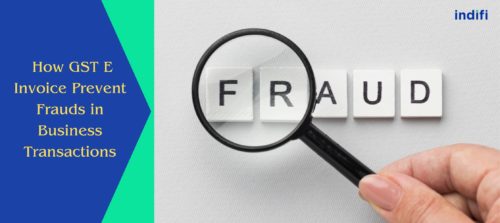
What is E-Invoice Under GST?
To simplify and digitize the invoicing process for goods and services taxation, the Goods and Services Tax Electronic Invoice, also known as GST e invoice was introduced on 1st October, 2020.
Businesses create invoices electronically through the GST e invoice system. This guarantees consistent forms and distinct document identification for every invoice.
The implementation of the Goods and Services Tax Electronic Invoice has become an essential tool. This electronic invoice helps in improving the integrity of financial transactions in the quickly changing business transactions landscape. The GST e invoice system’s digital approach not only transforms invoicing procedures but also plays an important role in preventing company fraud.
Structure Of A GST E-Invoice
| Field Name | Description |
| Invoice Number | A unique number linked to every electronic bill. |
| Invoice Date | The date on which the invoice is sent. |
| Seller’s GSTIN | The seller’s Goods and Services Tax Identification Number. |
| Seller’s Name | Legal name of the invoice’s issuer, the seller or business. |
| Seller’s Address | The seller’s or the invoice issuer’s physical address |
| Seller’s State | State where the seller has their GST registration. |
| Seller’s Pincode | The seller’s address pincode. |
| Buyer’s GSTIN | The buyer’s Goods and Services Tax Identification Number. |
| Buyer’s Name | Legal name of the invoice’s issuer, the buyer or supplier. |
| Buyer’s Address | The buyer’s or the invoice issuer’s physical address |
| Buyer’s State | State where the buyer has their GST registration. |
| Buyer’s Pincode | The buyer’s address pincode. |
| Invoice Value | The invoice’s total amount, including taxes. |
| Currency | The currency representing the amount on the invoice. |
| Payment Terms | Conditions set out for paying the invoice total. |
| Item Description | A description of the products or services offered. |
| Quantity | The quantity of products or services rendered. |
| Unit Price | The cost of the goods or services per unit. |
| Tax Rate (CGST) | The appropriate rate of the central goods and services tax. |
| Tax Rate (SGST) | Rate of the appropriate state goods and services tax. |
| Tax Rate (IGST) | Rate of applicable integrated goods and services tax. |
| Tax Amount (CGST) | The total amount of Central GST charged on the invoice. |
| Tax Amount (SGST) | Total amount of state tax applied to the invoice. |
| Tax Amount (IGST) | Total amount of integrated GST charged on the invoice. |
| Total Amount | Total amount due from the buyer, taxes included. |
| Place of Supply | The location of the delivery or provision of goods or services. |
| Invoice Type | Sort of invoice: bill of materials, tax invoice, etc. |
| Invoice Category | Type of invoicing, such business-to-business (B2B) or business-to-consumer (B2C). |
| Reverse Charge | Indicator indicating the application of the reverse charge process. |
| E-Way Bill Number | If appropriate, the Electronic Way Bill number. |
| Transport Details | Details about the delivery process, should products be delivered. |
| Digital Signature | To guarantee the invoice’s integrity and legitimacy, use a digital signature |
One must be aware about how to check a fake GST Invoice or Bill ?
How Does the GST E Invoice Prevent Frauds in Business Transactions?
Digital Traceability and Transparency
By improving traceability and transparency in company transactions, the GST e-invoice system reduces the risk of fraud. Because each invoice is individually recognized, authorities may expedite audits and conduct detailed examinations more quickly. There are two different types of audits statutory audit vs management audits. One must be aware about the same. This digital infrastructure discourages illicit activity in business interactions and promotes honesty.
Real-Time Validation and Authentication
By providing real-time validation and verification, the GST e-invoice system strengthens corporate transaction defences against fraud. Digital invoicing, as opposed to conventional paper-based procedures, allows for quick verification, guaranteeing prompt document validity confirmation. This quick validation feature reduces the possibility of fraudulent activity by quickly identifying and fixing inconsistencies or real-time manipulations.
Reduction of Duplicate Bills
The e-invoice system for GST reduces fraudulent activity in business transactions by a large amount, mainly via reducing the number of duplicate invoices sent. Each invoice is issued a unique identifying number through automatic production and centralization, making it difficult for fraudsters to produce counterfeit papers. Also read how to set up invoice discounting for your retail shop.
Simplified Verification of Input Tax Credit (ITC)
Input Tax Credit (ITC) verification is made easier by the GST e-invoice system, which supports business transaction anti-fraud initiatives. It improves accuracy by enabling smooth cross-verification of tax advantages and supplier data through automation. Financing transaction integrity in the GST system is strengthened by digital integration, and expediting the ITC procedure aids in preventing fraudulent claims. Here are few tax planning strategies for small and medium businesses.
Connectivity with the GST Network (GSTN) and Verification of Compliance
In the fight against business transaction fraud, the GST e-invoice system’s connection with the GSTN represents a critical milestone. Continuous data interchange is made possible by this smooth interface, which makes compliance checks and real-time monitoring easier. By using automation, irregularities are quickly identified, preventing fraud and guaranteeing legal compliance, all of which contribute to a safer workplace.
Also Read:- How to Check & Download GST Filing Status?
Takeaway
Overall, it can be said that the GST e invoice system is a revolutionary tool that strengthens the integrity of company transactions. With its real-time validation, digital traceability, and streamlined procedures, the system serves as a strong disincentive to fraudulent activity.
FAQ
What are the GST-related exclusions for e-invoicing?
The application of e-invoicing is not applicable to any provider of a taxable service that is an insurer, banking company, financial institution, or non-banking financial company. when the supplier is a goods transport company offering services associated with the road transportation of commodities in a truck.
What advantages do electronic invoices under GST offer?
When entering data by hand, e-invoicing aids in accuracy and data reconciliation. It makes business-to-business interoperability possible. The electronic invoices are real-time trackable. The tax return procedure will be simplified by the auto-population of e-invoice details on tax return forms and e-way bills.
What occurs if an electronic bill is not produced in less than seven days?
Businesses may be penalized if they neglect to create an e Invoice or send a legitimate tax invoice for GST-related issues. For each incident of non-compliance, this penalty might be 100% of the tax due or INR 10,000, whichever is higher.


